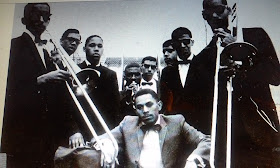Rafael Ithier of Puerto Rico is founder of the most popular
salsa group that ever existed—El Gran Combo
By the way, just for the record, I also enjoy merengue music, bachata, new age, classical, opera, and kompa music from Haiti, zouk music from the islands of Guadalupe and Martinique, and music from South Africa. I recently fell in love with the music of country & western singer Faith Hill. Pretty soon, I too will be a country music fan.
At the age of 16, I read my first book on African history while listening to the salsa music icon Ray Barretto and his orchestra on my stereo system. In those days, I thought the heavy drumming with the African style call-and-response in the Spanish lyrics was strictly Puerto Rican. I had no idea that the music I was enjoying is an offspring of the cultures that I was reading about in my African history book.
There is a group out of Senegal, West Africa known as Africando who stated on their first CD that their mission is to bring salsa music back to its African roots. They sing their salsa songs in Spanish, French, and in their tribal tongue Wolof.
Many West Africans are cognizant of the connection between their music and salsa. In Benin, West Africa, salsa is the most popular music with clubs located throughout the country. Vodoun, Benin’s traditional religion, gave birth to the tamtam and the bells that are used in salsa music.
“Our mission is to bring salsa music back to its African roots”
—Grupo Africando, Senegal, West Africa
While on the phone with a girlfriend, a Nigerian of the Edu tribe, I played her a cut consisting of nothing but percussion from one of my CDs, and asked her to guess who these people are. Her immediate response was,“hmmmm they sound like the Yoruba tribe of Nigeria. She was close! The drummers she heard were Afro-Cuban drummers who maintained linguistic, cultural, and religious ties with the Yoruba people of West Africa.
Imagine during the infamous slave trade, two siblings (boys) growing up together in a Yoruba village of West Africa. Both are abducted by slave traders The older brother is taken to a cotton field in Mississippi, and his younger brother to a sugar estate in Cuba. The brother in Mississippi is severely whipped and forced to forget his Yoruba tongue, change his name, learn English, convert to Christianity, and is forbidden to play the drums. His brother in Cuba is also severely beaten, forced to change his name, learn Spanish, convert to Catholicism, but is allowed to maintain his Yoruba language and culture, and play the drums.
The best salseras (salsa dancers) I've ever danced with were
Afro-Cuban woman when I visited Havana, Cuba years back
Fast-forward to today, the descendants of the young boys know absolutely nothing about their family history before their arrival in the Americas, and culturally speaking, the two are so far apart, they would have no way of recognizing each other if they were to ever cross paths. Both descendants, despite their dark skin, brown eyes, and wide nose would see each other as “foreigners.”
The descendant of the boy in Mississippi, an admirer of the late R&B singer Luther Vandross, grows up in a Baptist church in Chicago; starts off as a gospel singer before embracing a career in rhythm and blues, and later cuts his first CD with his band.
Descendants of the boy in Cuba grows up in the Santería religion, an underground, clandestine religious sect where African slaves surreptitiously retained their old Yoruba religion under the guise of the Catholic church. He also becomes a member of an Afro-Cuban social group known as the Lucumí for which its music became the cornerstone for the music today we today call “salsa.” He now performs with the world famous Afro-Cuban dance troupe Muñequitos de Matanzas.
.
Many of today's salsa music legends based their music on the original works
of Cuba's tres player (a three-stringed guitar) Arsenio Rodriguez
Unlike black American music, which has it’s origin in Negro spirituals, which is American born. Salsa is an offspring of straight-forward African-based music mixed with Spanish. Over time, Cuban and Puerto Rican immigrants to New York City like Mario Bauza, Ray Barretto, and Tito Puente added more improvisations to Afro-Cuban music, which became Latin jazz, Latin soul, and salsa.





